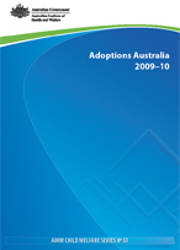Summary
Background
This report presents the latest data on adoptions by Australian families of Australian children and children from overseas. Adoption is one of a range of options used to provide care for children who cannot live with their birth families. The report also highlights important national trends in adoptions over the last few decades.
Data for this report were obtained from the Australian Institute of Health and Welfare (AIHW) Adoptions Australia data collection. This data collection is a record of all finalised adoptions in Australia since 1990–91, collected from each state and territory department responsible for adoption.
Main findings
Since the early 1970s, there has been a 21–fold decrease in the number of adoptions in Australia— from 8,542 in 1972–73 to 412 adoptions in 2009–10. However, the total number of adoptions has remained relatively stable since the late-1990s, at around 400 to 600 children per year.
The overall decline in adoptions can be attributed to a fall in the number of Australian children adopted (including local and ‘known’ child adoptions). In contrast, intercountry adoptions have increased overall in the last 25 years, and have emerged as the dominant category of adoptions— representing 54% of all adoptions in 2009–10, compared with 10% in 1984–85.
In 2009–10:
- There were 412 adoptions in Australia (1.9 per 100,000 population)—the lowest number of adoptions recorded since reporting commenced, and a 7% decline from the previous year. Of these, 54% were intercountry, 15% were local and 31% were ‘known’ child adoptions (see Glossary for definitions).
- The majority of intercountry adoptees came from the Asian region (82%). The three most common countries of origin in Asia were the Philippines (22%), China (14%) and South Korea (14%). Ethiopia was the most common country of origin outside the Asian region (15%).
- Overall, 65% of adopted children were aged under 5 years. In local and intercountry adoptions, nearly all children were under 5 years (100% and 86%, respectively).
- Of the children in local and intercountry adoptions, 39% and 63% respectively had adoptive parents aged 40 years and over. The majority of local and intercountry adoptees were adopted into families with no other children (75% and 58%, respectively).
- Nine in ten (92%) local adoptions could be considered ‘open’—that is, all parties were open to freely discussing the adoption within their families, and were happy to allow contact to occur between families. The remaining 8% were adoptions where birth parents had requested no contact or information between them and the adopting family.
- Three Aboriginal and Torres Strait Islander children were adopted in 2009–10, with a total of 63 Indigenous children being adopted over the last 15 years.
- Two-thirds (67%) of ‘known’ child adoptions were of children were aged 10 years and over.
- For ‘known’ child adoptions, 57% of adoptions were by step-parents and a further 41% were by carers.



